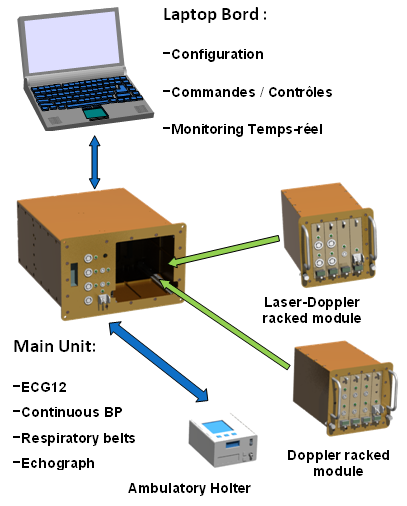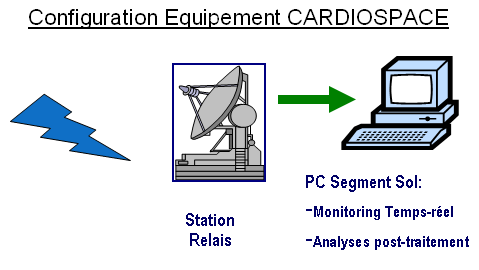Mission

Scientific Objectives
1 - Why study the cardiovascular system in microgravity
After a space flight, the cosmonauts have a cardiovascular deconditioning no matter how long the flight lasts. The main symptom is the syncope with orthostatic hypotension. At the operational level, the cardiovascular deconditioning may compromise the phase that comes just after the space mission's return on Earth; efficient countermeasures must therefore be developed. At a more fundamental level, the study of cardiovascular deconditioning enables to establish the links between gravity, the level of physical activity, and containment on the one hand, and the dysfunction of the cardiovascular system on the other (figure 1).
![]()
FIGURE 1: Actual or simulated weightlessness and cardiovascular deconditioning
Numerous mechanisms are potentially involved in this cardiovascular deconditioning as shown in figure 2. The vascular injuries have not been sufficiently studied until now while the vascular and microvascular function which controls not only the regulation of the blood pressure but also the regional blood flows (such as cerebral or muscular blood flows) has not been subjected to studies.
![]()
FIGURE 2: Mechanisms involved in cardiovascular deconditioning
2 - Advantages of the "CARDIOSPACE" system
We studied the cardiovascular system in microgravity for several years, particularly in the framework of the French-Russian cooperation. Physiolab and now CARDIOMED study some aspects of cardiovascular deconditioning—the autonomous nervous system, venous properties and blood flow in the conduction vessels.
The CARDIOSPACE system will study cardiovascular deconditioning by focusing on:
- Skin microcirculation with a Laser Doppler system and various physiological non-invasive stimulations to analyze the mechanisms of microcirculation injury. Skin microcirculation is interesting in itself due to its high reactivity, its extension and its role in thermoregulation. It can also be considered as a reflection of the general microcirculation. Studies on Earth have shown skin microcirculation was modified by microgravity simulations. These results must be compared with in-flight data.
- Macrocirculation and its morphological aspects, using ultrasounds. These ultrasound measurements enable to study the vascular remodelling induced by microgravity. Studies on Earth have shown a significant remodelling of the different vessels depending on if we study the lower part of the body or the head part. The ultrasound will also enable to conduct studies on some parenchymal vascular flows (including hepatic, renal, and digestive flows), on cardiac functions, and will be used as much as possible as a diagnostic means and morphological tool.
This CARDIOSPACE system is the extension of studies that we have already conducted with Physiolab and that we are conducting with CARDIOMED. It enables to study the cardiovascular deconditioning in an integrated way and targeting the microcirculation and the macrocirculation.
It is a unique system at the international level integrating all these tools for a combined use, enabling a functional study of skin microcirculation.
This project is led in collaboration between our clients, the French scientific doctors (Angers and Tours hospitals), and the Chinese scientific doctors (ACC).
Mission
The CARDIOSPACE equipment should enable to set up clinical trials, which aim to study the cardiovascular system in microgravity. The trials should be performed both on Earth (pre and post-flight measurements) and in space.


The dimensioning clinical trials and the associated physiological measurements that should be acquired on the Taikonauts are the following:
- Microcirculation: skin blood flow (with stimulation by heating and iontophoresis) and continuous blood pressure, brachial blood pressure, electrocardiogram.
- Macrocirculation (vascular remodelling, cardiac function, etc.): ultrasound, arterial flow and continuous blood pressure, brachial blood pressure, electrocardiogram, respiratory rate.
- Medical monitoring: brachial blood pressure and electrocardiogram, ambulatory monitoring over 24 hours.
Each trial generally requires the use of several medical instruments which will be integrated in the CARDIOSPACE equipment. These instruments are:
- CNAP OEM, CN-system: continuous blood pressure
- Doppler Waki, Atys: arterial flow
- EMI12, Corscience: electrocardiogram
- Respiratory belt, TSD201 Biopac: respiratory rate
- Holter Spiderview, Sorin: ambulatory electrocardiogram
- Holter Tonoport V, Par: brachial pressure (ambulatory or non ambulatory)
- Echographe, T3200, Terason: ultrasound
- Laser Doppler, Periflux 5000, Perimed: skin blood flow
During a trial, several instruments must work simultaneously. A fine synchronization of the measurements acquired by the different instruments is mandatory. To reach these time-tagging performances, an integration and a synchronization of the different instruments is required.
Due to its use on board the future orbital laboratory TianGong 2, the CARDIOSPACE equipment must integrate medical instruments adapted to space constraints and must satisfy the qualification and interface requirements of the Chinese orbital laboratory.
